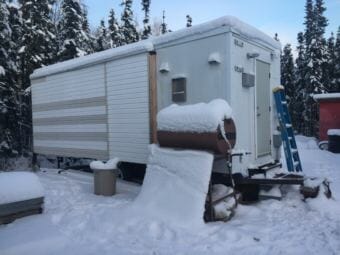
When people want to bring down their heating bill in Fairbanks — where winter temperatures often dip into the negative double digits — they’ll sometimes try to improve the energy efficiency of their homes by adding more insulation on the outside of their house.
But there’s a pitfall to watch out for: mold.
At the Cold Climate Housing Research Center in Fairbanks, there’s an experiment underway to try to find a cheaper way to make that kind of retrofit while still keeping risk of mold low.
Research engineer Robbin Garber-Slaght leads the way behind the back of the main building to a shipping container in a stand of black spruce.
Inside are heaters, pipes, a humidifier and a huge humming fan, which are mimicking the conditions you might find in a house with high humidity. The walls of the container have been divided into nine sections with different types and thicknesses of insulation behind them. Each wall also contains wires with sensors that pick up temperature, moisture content and other data.
“All those wires go back to our central station where we’re recording everything,” Garber-Slaght said.
The problem that the Cold Climate Housing Research Center is trying to solve here has to do with moisture — and money. Since foam can be expensive, people often opt for something like two inches when they’re doing a retrofit.
“Every summer driving through Fairbanks, I will see somebody adding this kind of retrofit to their home,” Garber-Slaght said.
Here’s the issue with that: Every home has moisture in the air. It’s created by breathing, cooking, showering. And that moisture can find its way into the walls through various leaks.
In a poorly-insulated house with no foam on the outside, that moisture can condense inside the walls, freeze, and then evaporate to the outside of the house when summer rolls around — at least in a dry climate like Fairbanks.
But with something like two inches of foam, the inside of the walls will likely be cold enough for the air moisture to condense into water, but not so cold that it freezes. And when summer comes, the foam can act like a barrier and prevent the water from evaporating out.
Those are ripe conditions for mold, according to Garber-Slaght. The test wall is evidence. She said after one winter, they opened the wall to look inside: “This wall that had two inches of (expanded polystyrene) bead board on the outside of it grew mold.”
Garber-Slaght added that in most houses in Fairbanks it could take longer for mold to become a problem. It may not become evident for years, but when it does, it can create all kinds of health issues.
The problem can be solved by adding enough insulation that the air in the walls stays close to the temperature of the air in the house. That standard will be different in different climate zones. But in a place as cold as Fairbanks, that standard can be about six inches of foam — which is really expensive.
Thus this experiment, which the Cold Climate Housing Research Center hopes will help them come up with a cheaper option.
In the meantime, Garber-Slaght said there are other things homeowners can try that don’t carry the same cost. Like getting a home energy audit to help identify leaks.
“Hot air moving through holes in the wall is really easy to block up, and it’s a huge energy saver,” Garber-Slaght said.
She also suggested insulating the attic, since a lot of heat can be lost through the top of the house.
As for adding insulation to the walls, Garber-Slaght said homeowners across the state should talk to a professional first to figure how much insulation is needed to keep risk of mold low.




